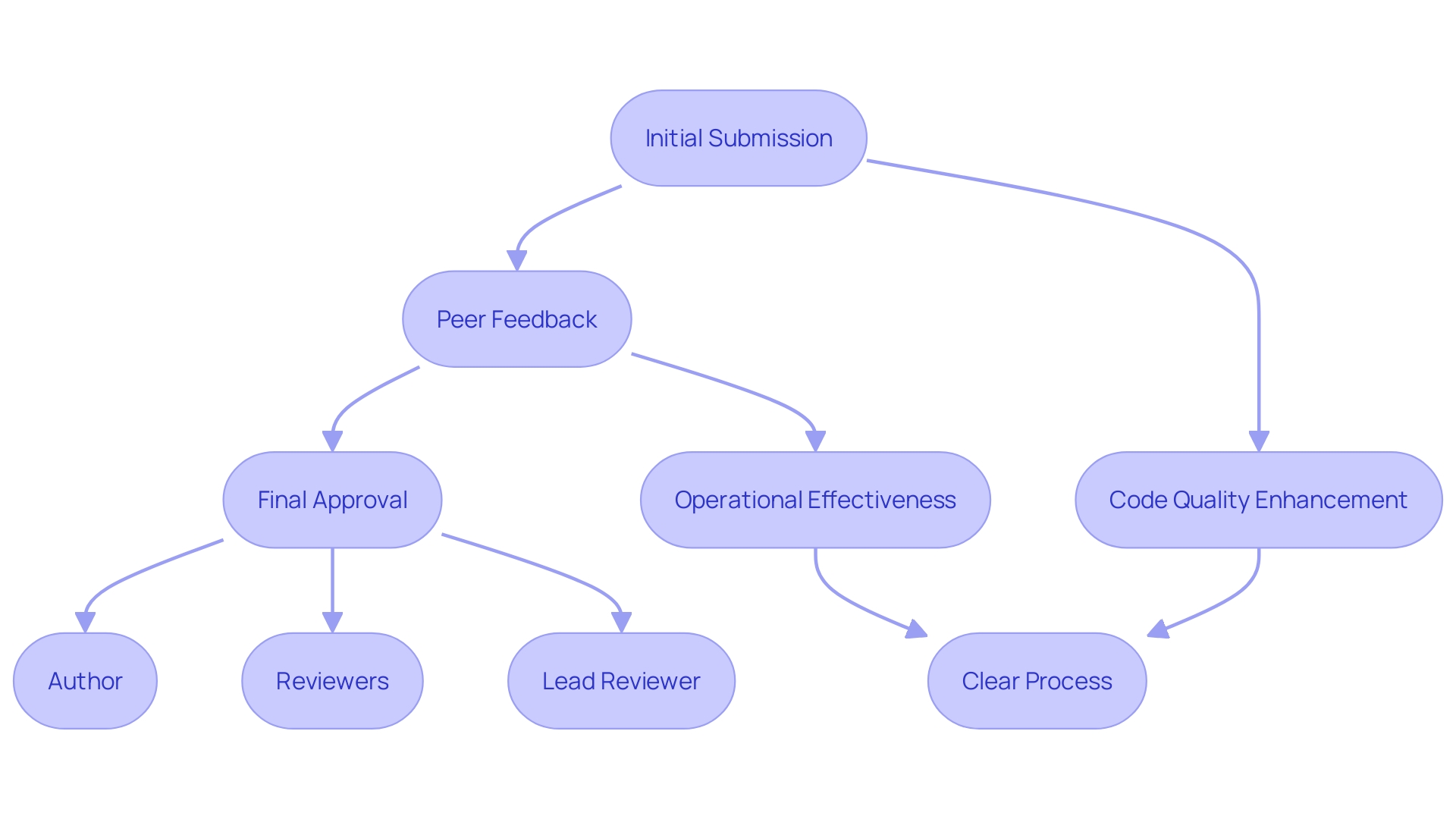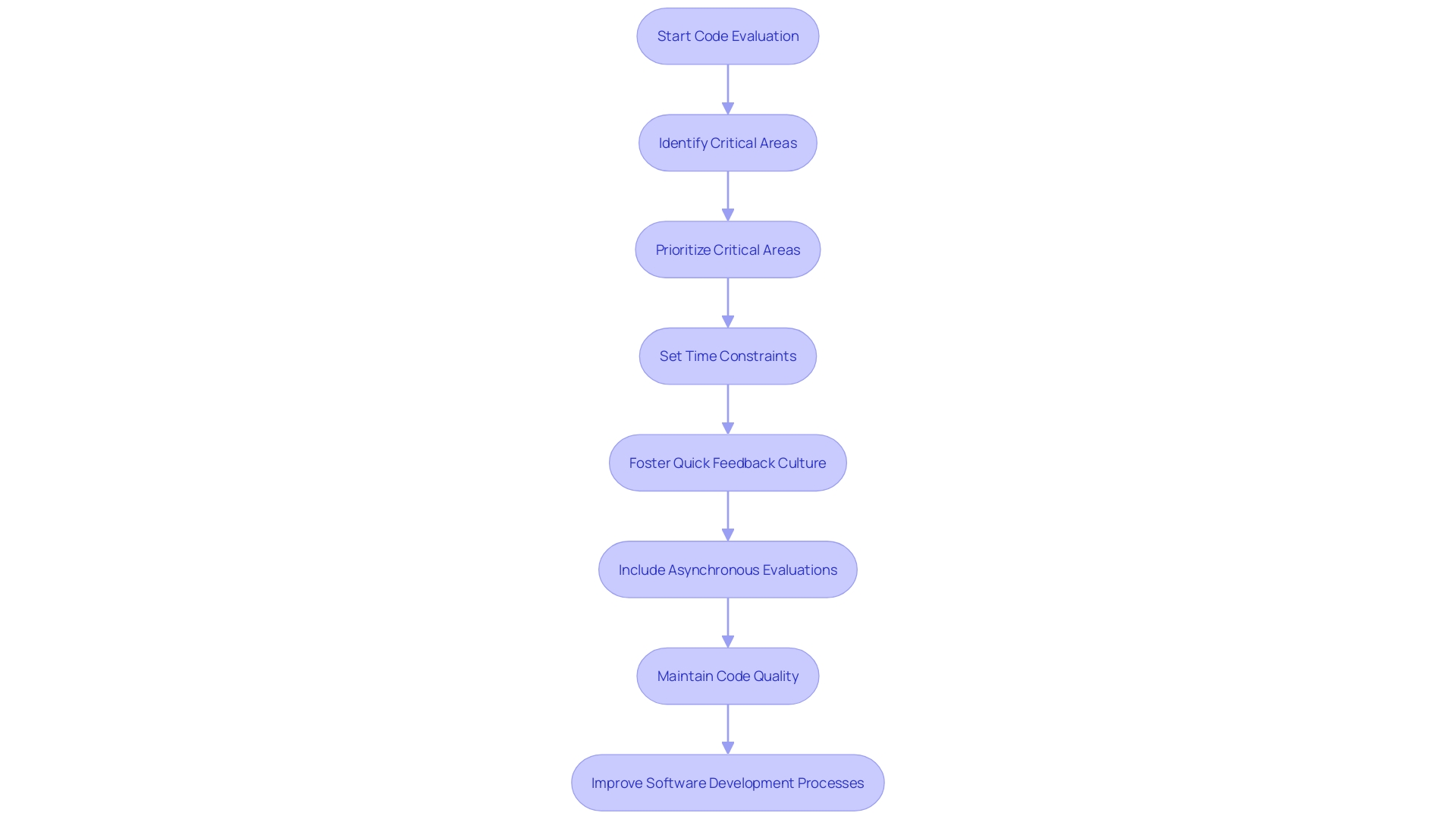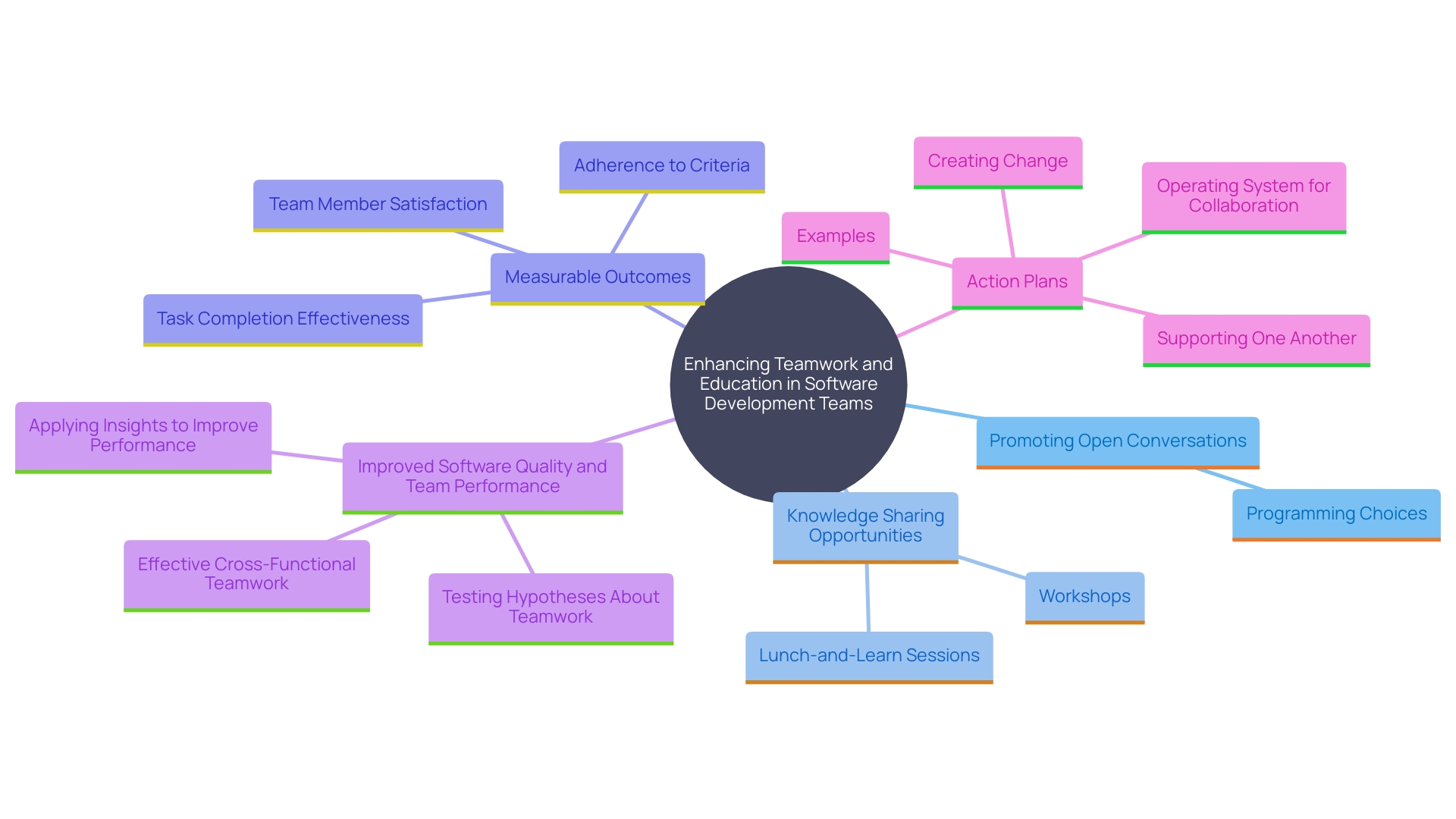Introduction
Maintaining high-quality code and operational efficiency is a critical aspect of software development, and a structured code review process is essential to achieve this goal. From defining a clear workflow and roles to utilizing advanced tools and promoting a culture of collaboration, every element plays a vital role in enhancing productivity and ensuring code reliability. This article delves into the practical steps for setting up an effective code review process, establishing clear objectives and checklists, balancing thoroughness with efficiency, leveraging technology, and implementing best practices.
By integrating these strategies, teams can maximize the benefits of peer reviews, resulting in superior code quality and a more cohesive development environment.
Setting Up a Structured Code Review Process
Establishing an organized code assessment system is essential for preserving superior code quality and operational effectiveness. A well-defined workflow sets clear expectations, minimizes misunderstandings, and promotes consistency across the team. Start by defining the stages of review, which typically include initial submission, peer feedback, and final approval. Explicitly outline the roles involved, such as the author, reviewers, and a lead reviewer.
Utilize a version control system to streamline the process, making it easier to track changes and comments. Ensure that comments are up-to-date and reflect recent modifications, adhering to the project's style. For example, in a Python function, comments should explain the use of a specific algorithm due to its efficiency, like using QuickSort for O(n log n) performance on large datasets.
Review documentation for accuracy, completeness, and clarity. It should represent the current condition of the software, encompassing system structure and interactions, and be accessible to newcomers. For instance, a software design document might outline the architecture, data flow, and external dependencies of a microservices-based application.
Effective evaluations by colleagues are essential in software development, helping maintain quality and promote adherence to standards, style guides, and project requirements. Nevertheless, the efficiency of evaluations decreases significantly with the magnitude of the alteration. Extensive reviews of the program can be tiring and less efficient, so it's recommended to limit the size of pull requests (PRs).
Offer input that is helpful and practical, concentrating on the programming rather than the programmer. Ask questions if something is unclear rather than making assumptions. Highlight positive aspects of the program, not just areas needing improvement. Be accessible to reassess the script after the developer responds to the feedback, and utilize insights from the evaluation to consistently enhance standards and methods.
As highlighted by specialists, the peer evaluation method is vital for software creation, promoting learning and knowledge exchange while guaranteeing compliance with standards. By incorporating assessment of programming as a fundamental part of the development process, teams can harness its full benefits.

Defining Clear Objectives and Establishing a Review Checklist
Setting clear goals for review sessions is crucial for enhancing their effectiveness. Start by developing a thorough checklist that encompasses essential criteria such as functionality, compliance with established programming standards, and detection of possible security vulnerabilities. This organized method not only directs reviewers but also clarifies expectations for the author of the program. Incorporating particular elements such as performance factors and software maintainability further improves the assessment procedure, resulting in more comprehensive evaluations. In today's complex and evolving software development landscape, leveraging automated tools and AI can significantly support these efforts, ensuring accuracy and efficiency in identifying issues. As emphasized by recent progress at Microsoft and Google, AI-driven methods are becoming more essential for improving software development practices and boosting programming standards.
Balancing Thoroughness and Efficiency in Code Reviews
Balancing thoroughness and efficiency during code evaluations is essential to prevent bottlenecks while maintaining code quality. Reviewers should prioritize examining critical areas that influence functionality and performance, while also being mindful of time constraints. Establishing time constraints for evaluations can assist in sustaining momentum and avoiding delays. Moreover, promoting a culture that values quick feedback can enhance the overall efficiency of the process.
Asynchronous evaluations can further support this balance. By allowing reviewers to examine the material at their convenience, independent of the author’s presence, it provides flexibility for in-depth analysis without the pressure of real-time feedback. This approach helps ensure that the final product is high quality and integrates well with the existing codebase.
Furthermore, concentrating on the final structure, logic, and compliance with programming standards is essential. Reviewers should also consider the code’s impact on the overall architecture and future maintainability. Ongoing enhancement of guidelines and practices, informed by insights from the evaluation, is essential for upholding high standards in software development.
Encouraging constructive and actionable feedback is another vital aspect. 'Security considerations, such as identifying vulnerabilities like SQL injection or XSS, should be part of the assessment process.'. Ensuring that feedback is centered on the program rather than the developer helps foster a supportive and collaborative team environment. By following these practices, teams can attain a balanced method for assessments, improving both efficiency and quality of the software.

Leveraging Tools and Technology for Effective Code Reviews
Utilizing the capabilities of sophisticated instruments and technology can significantly simplify the programming evaluation process. Platforms such as GitHub, GitLab, and Bitbucket incorporate advanced assessment features, allowing accurate and effective remarks directly on particular lines of programming. Automated testing tools are crucial as they perform pre-checks to identify errors before the review begins, thus saving time and reducing manual effort.
Furthermore, static analysis tools play a crucial role in identifying design flaws and potential issues early in the development cycle. These tools allow developers to focus on more complex and creative tasks rather than getting bogged down by mundane error checks. This can significantly enhance productivity and maintainability, which is particularly critical in industries with stringent regulatory requirements, such as banking.
For instance, at Google, the implementation of machine learning-suggested modifications has substantially increased productivity by allowing engineers to concentrate on more sophisticated challenges. Similarly, M&T Bank has acknowledged the significance of upholding high quality standards to protect against security breaches and ensure smooth operations.
The incorporation of AI in programming assessments signifies a notable transition towards more effective and user-friendly procedures. AI-driven models, like those used by Cursor Tab, can forecast the most probable subsequent actions based on the programming context, further enhancing the evaluation workflow. This not only decreases the time dedicated to assessments but also improves the precision and standard of modifications.
In conclusion, the adoption of these advanced tools and AI technologies is transforming the landscape of software development, making evaluations more efficient, thorough, and less time-consuming. The potential of programming assessments depends on utilizing these smart instruments to attain greater efficiency and improved software standards.
Best Practices for Peer Code Review
Applying optimal techniques for peer evaluations greatly improves software quality, teamwork, and knowledge exchange among group members. Encourage reviewers to provide constructive feedback that focuses on the code rather than the coder, helping to improve the work without personal criticisms. Setting up regular evaluation sessions is essential for accountability and steady progress. These sessions also foster a collaborative environment where team members can learn from each other.
Rotating evaluation responsibilities is another effective strategy. It exposes developers to different coding styles and practices, broadening their perspectives and enhancing their skills. This practice not only improves individual capabilities but also ensures the team adheres to a consistent set of coding standards, reducing errors and inconsistencies.
Furthermore, evaluations should be a chance for ongoing enhancement. Utilize insights from the evaluation process to enhance guidelines and practices over time. Efficient evaluations among colleagues are crucial for upholding high standards in software development, guaranteeing that the programming is of excellent quality, secure, and efficient. By following these guidelines, teams can create a supportive environment that drives both personal and collective growth.
Promoting a Culture of Collaboration and Learning
Promoting an environment of teamwork and ongoing education is essential for efficient reviews. Promoting open conversations regarding programming choices and embracing varied viewpoints can greatly improve the shared knowledge of a team. Providing opportunities for team members to share knowledge and experiences is essential. For instance, Woody Zuill, a renowned Agile Coach and originator of the Mob Programming approach, emphasizes the importance of simple, clean, and maintainable software through constant inspection and adaptation. Arranging workshops or lunch-and-learn gatherings centered on code review methods can enhance this cooperative atmosphere, ultimately resulting in better code. Additionally, metrics such as the effectiveness of task completion, adherence to predefined criteria, and team member satisfaction can be tracked to measure the impact of these collaborative initiatives. This holistic approach not only fosters a productive work culture but also addresses the specific challenges faced by software developers, leading to enhanced software quality and overall team performance.

Conclusion
Implementing a structured code review process is crucial for enhancing code quality and operational efficiency in software development. By establishing a clear workflow and defining roles, teams can minimize misunderstandings and promote consistency. Utilizing advanced tools like automated testing and static code analysis further streamlines the process, allowing developers to focus on more complex tasks.
Setting clear objectives and creating a comprehensive review checklist guide reviewers and clarify expectations for code authors. This structured approach helps identify critical areas such as functionality and security vulnerabilities while balancing thoroughness and efficiency to prevent bottlenecks.
Promoting a culture of collaboration and continuous learning is vital for effective peer reviews. Encouraging open discussions and knowledge sharing fosters an environment where team members learn from one another. Rotating review responsibilities enhances individual skills and reinforces adherence to coding standards.
By integrating these strategies and best practices, teams can achieve superior software quality and a more cohesive development environment. Ultimately, a well-structured code review process equips teams to effectively tackle the challenges of modern software development, driving productivity and ensuring high-quality outcomes.
Frequently Asked Questions
What is the purpose of establishing a code assessment system?
Establishing a code assessment system is essential for maintaining superior code quality and operational efficiency. It sets clear expectations, minimizes misunderstandings, and promotes consistency within the team.
What are the typical stages of a code review?
The typical stages of a code review include: Initial submission, Peer feedback, Final approval.
Who are the key roles involved in the code assessment process?
The key roles involved in the code assessment process are: The author of the code, Reviewers, A lead reviewer.
How can version control systems aid in code assessments?
Version control systems streamline the code assessment process by making it easier to track changes and comments, ensuring that all feedback is up-to-date and relevant to recent modifications.
What should review documentation include?
Review documentation should be accurate, complete, and clear, reflecting the current state of the software, including system structure, interactions, and accessibility for newcomers.
Why is peer evaluation important in software development?
Peer evaluation is crucial as it helps maintain quality, ensures adherence to standards, style guides, and project requirements, and promotes learning and knowledge exchange among team members.
How can the size of pull requests (PRs) affect the efficiency of evaluations?
Larger pull requests can lead to decreased efficiency in evaluations, as extensive reviews can be tiring and less effective. It is recommended to limit the size of PRs to enhance review efficiency.
What are some strategies for providing effective feedback during code reviews?
Effective feedback should: Be helpful and practical, Focus on the programming, not the programmer, Ask questions for clarification, Highlight positive aspects alongside areas for improvement.
How can automated tools and AI improve the code evaluation process?
Automated tools and AI can enhance the evaluation process by identifying issues early, performing pre-checks for errors, and allowing engineers to focus on complex tasks rather than mundane error checks.
What role does ongoing improvement play in the code assessment process?
Ongoing improvement is vital for maintaining high standards in software development. Teams should utilize insights gained from evaluations to refine guidelines and practices continuously.
How can teams foster a collaborative environment during code assessments?
Teams can promote collaboration by: Encouraging open discussions about programming choices, Setting up regular evaluation sessions, Rotating evaluation responsibilities among team members.
What metrics can help measure the impact of collaborative initiatives in software development?
Metrics to measure the impact of collaborative initiatives may include: Task completion effectiveness, Adherence to predefined criteria, Team member satisfaction.
How important is it to balance thoroughness and efficiency in code evaluations?
Balancing thoroughness and efficiency is crucial to prevent bottlenecks in the review process while ensuring high code quality. Establishing time constraints and promoting a culture of quick feedback can help maintain this balance.




